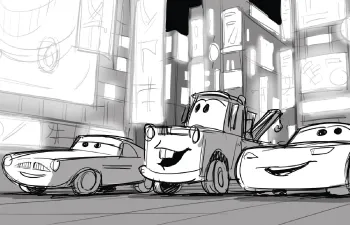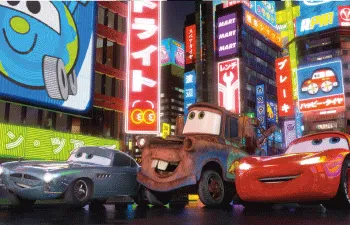Pixar began as a struggling hardware developer but has become a Hollywood icon. Its clutch of scientific and technical Academy Awards are matched only by its 11 artistic Oscars. It made stars not only of Woody and Buzz Lightyear but also of John Lasseter, its bespectacled and perpetually Hawaiian-shirted chief creative officer.
If ever there was a company that put a human face on animation technology, that company was Pixar Animation Studios. This year, Pixar celebrates its 25th year as an independent business and the release of its 12th animated feature, Cars 2. From its earliest days as a hardware developer – the Pixar Image Computer was originally used in the medical and defence markets – the company’s technology has been inextricably intertwined with the development of the computer graphics industry. Its early short films, like Luxo Jr, and its debut feature film, Toy Story, introduced the world to RenderMan, now the industry-standard software for rendering (the process of generating finished 2D images from the geometry, surfacing and lighting data used to create a 3D animation).
Pixar’s subsequent films act like a timeline of technological developments in computer graphics. Building on the work of other researchers, 2001’s Monsters, Inc. introduced the on-screen representation of fur. Two years later, Finding Nemo pioneered new techniques in digital lighting, which were used to create realistic-looking water. The Incredibles and Ratatouille brought with them believable human characters, and advances in the simulation of crowds and fluids.
But in recent years, the scale of those technological breakthroughs has changed. Whereas early films introduced entire new types of physical phenomena to be simulated digitally, by the time 2009’s Up came along the advances were confined to the improved simulation of balloons and feathers. So have Pixar and its rival animation studios simply run out of new things to discover?
“I would say the breakthroughs are just as difficult today as they’ve always been,” says Apurva Shah, supervising technical director on Cars 2. “But 10 years ago, there was an element of, ‘Okay, we really don’t know how to do this,’ and that’s not as prevalent today.” According to Shah, 3D animation can now recreate most real-world phenomena with a greater or lesser degree of ease. “We may not have elegant solutions for everything. Some of the computational techniques rely on brute force a lot,” he says. “But we do now have a pretty good sense of how to create pretty much anything a film may call for.”
The problem with people
While most modern animation problems can be solved with extra computing muscle, studios still struggle to create digital humans that don’t have the unwanted effect of making the audience’s skin crawl. Early photorealistic human characters, such as those seen in 2004’s The Polar Express, were panned by critics for their dead-eyed, uncannily robotic qualities.

Since then, the development of new techniques for simulating human skin – such as subsurface scattering, a technique that simulates how light is absorbed, scattered and re-emitted by skin – have led to more realistic digital skin. And advances in performance capture have made it possible to record an actor’s facial movements in ever greater detail, before transferring them to a character. Both developments have brought us to the brink of having convincing digital actors on screen.
But, according to Rob Bredow, Chief Technology Officer at Sony Pictures Imageworks and visual effects supervisor on animated movies such as Cloudy With A Chance Of Meatballs, the issue is again one of consistency. “We probably have most of the individual components,” he says. “Our subsurface scattering models are pretty accurate, the optical calculations for eyes are pretty good and our animation has matured to the point at which we can create subtle movements you find believable. What’s interesting is that sometimes those parts add up to very good result – but sometimes they don’t.”
The problem, Bredow believes, is that people are better at subconsciously registering what constitutes realistic human behaviour than we are at articulating it. “We’re so good at perceiving those subtleties of performance, it’s sometimes very difficult to put your finger on why a particular shot isn’t quite right,” he says. “If it were just a technological problem, it would be a simple fix. But it seems it’s the sum of the parts.”
Refining the process
While studios can focus on the minutiae of perfecting their animations, cinema-goers of the future will have higher expectations than ever before, making productions more and more demanding.
Although hardware advances annually, Blinn’s Law (named after former NASA researcher and computer graphics pioneer Jim Blinn) states that, no matter how fast computers get, the average time taken to render a frame of animation stays the same. In part, this extra processing power is soaked up by increasing complexity: more detailed models, larger sets and more characters on screen simultaneously. But faster, more powerful computers also permit the use of more computationally demanding techniques.
One of these is global illumination. A group of algorithms calculate the way light bounces from surface to surface within an environment. It produces beautifully soft, subtle, natural-looking effects – but only if you’re prepared to wait for the effect to be added once the animation has been done. Now – thanks in part to work done by videogames companies to optimise the algorithms so they can work while a game is played – it’s increasingly being adopted on animated movies.

Animation companies are now using this real-time technology to develop workflows more like those of live-action movie making. Traditionally, studios would have to animate the characters and set before a shot could be lit and rendered, resulting in a delay of weeks or even months before a director could offer feedback. Now, smart graphics processors enable everything to be previewed much earlier in production.
From a purely technological point of view, this could halve the time necessary to make an animated feature. But rather than rushing the movie into cinemas a year early, Bredow hopes the time saved will be re-invested in refining the end result. “The most interesting challenge is to create tools that ‘disappear’ for the artist: that don’t interrupt creative workflow,” he says. “It used to be that only five to ten per cent of your day was spent on creative improvements: the rest went on data management, solving problems and troubleshooting. Today, that percentage is much higher.” Style and substance
This philosophy of placing technology in the service of artists, not vice versa, is central to Pixar’s success. Rather than slavishly recreating reality, much of the company’s recent research centres on ways to give its staff artistic control over it. One example of this philosophy at work is Pixar’s new method for calculating motion blur. Since it mimics the behaviour of a real camera, conventional CG blur often ‘smears’ out the little pauses – or ‘holds’, as they’re known – that artists add to an animation for effect. With Pixar’s system, movement starts out crisp, then blurs gradually, creating an effect more like that you’d expect to see in a traditional 2D cartoon.
“We call it ‘animation-friendly’ motion blur,” says Shah. “These sorts of things may not be big leaps technologically, but they make a big difference to the end result.”
Pixar is also looking forward to how it can better use the colour palettes. Whereas physically accurate lighting tends to result in dull, greyish hues in darker areas of a rendered frame, Shah and his colleagues are working on ways to ‘cheat’ the settings to preserve vibrancy. “It’s not a physically accurate effect: it’s a stylisation,” he says. “You’re still grounding yourself in physics, because the renderer is physically-based. But as an artist, you want to add your own twist.” The company is also working on new methods for non-photorealistic rendering – computational methods for stylising an image – opening up the possibility of animated movies that resemble graphic novels or watercolour paintings. The result could be a new breed of animated features that don’t look anything like what has gone before.
Once again, Pixar is leading the way: its first 25 years were spent trying to recreate reality in ever-greater detail but its next 25 may be spent recreating a very different world: that of the artist’s imagination.
“Until recently, realism was the gold standard that we were aspiring to,” says Shah. “Now, we’re trying to break out of those shackles.”
Jim Thacker is consultant editor of 3DWorld magazine
Follow Science Focus onTwitter,Facebook, Instagramand Flipboard